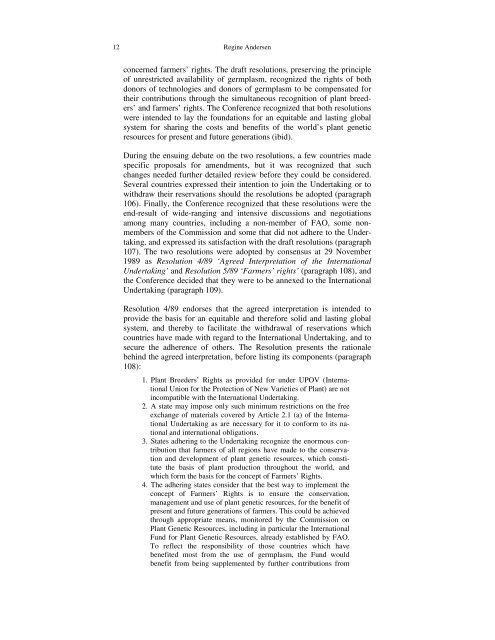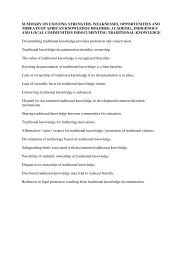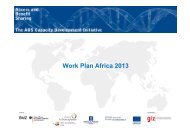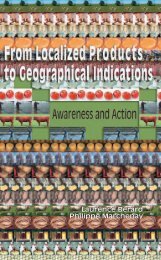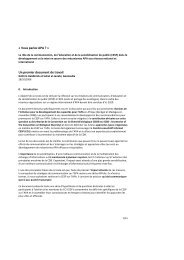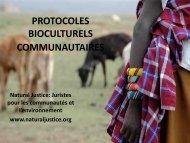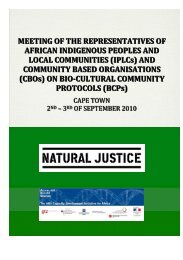The History of Farmers' Rights - Fridtjof Nansens Institutt
The History of Farmers' Rights - Fridtjof Nansens Institutt
The History of Farmers' Rights - Fridtjof Nansens Institutt
You also want an ePaper? Increase the reach of your titles
YUMPU automatically turns print PDFs into web optimized ePapers that Google loves.
12 Regine Andersen<br />
concerned farmers’ rights. <strong>The</strong> draft resolutions, preserving the principle<br />
<strong>of</strong> unrestricted availability <strong>of</strong> germplasm, recognized the rights <strong>of</strong> both<br />
donors <strong>of</strong> technologies and donors <strong>of</strong> germplasm to be compensated for<br />
their contributions through the simultaneous recognition <strong>of</strong> plant breeders’<br />
and farmers’ rights. <strong>The</strong> Conference recognized that both resolutions<br />
were intended to lay the foundations for an equitable and lasting global<br />
system for sharing the costs and benefits <strong>of</strong> the world’s plant genetic<br />
resources for present and future generations (ibid).<br />
During the ensuing debate on the two resolutions, a few countries made<br />
specific proposals for amendments, but it was recognized that such<br />
changes needed further detailed review before they could be considered.<br />
Several countries expressed their intention to join the Undertaking or to<br />
withdraw their reservations should the resolutions be adopted (paragraph<br />
106). Finally, the Conference recognized that these resolutions were the<br />
end-result <strong>of</strong> wide-ranging and intensive discussions and negotiations<br />
among many countries, including a non-member <strong>of</strong> FAO, some nonmembers<br />
<strong>of</strong> the Commission and some that did not adhere to the Undertaking,<br />
and expressed its satisfaction with the draft resolutions (paragraph<br />
107). <strong>The</strong> two resolutions were adopted by consensus at 29 November<br />
1989 as Resolution 4/89 ‘Agreed Interpretation <strong>of</strong> the International<br />
Undertaking’ and Resolution 5/89 ‘Farmers’ rights’ (paragraph 108), and<br />
the Conference decided that they were to be annexed to the International<br />
Undertaking (paragraph 109).<br />
Resolution 4/89 endorses that the agreed interpretation is intended to<br />
provide the basis for an equitable and therefore solid and lasting global<br />
system, and thereby to facilitate the withdrawal <strong>of</strong> reservations which<br />
countries have made with regard to the International Undertaking, and to<br />
secure the adherence <strong>of</strong> others. <strong>The</strong> Resolution presents the rationale<br />
behind the agreed interpretation, before listing its components (paragraph<br />
108):<br />
1. Plant Breeders’ <strong>Rights</strong> as provided for under UPOV (International<br />
Union for the Protection <strong>of</strong> New Varieties <strong>of</strong> Plant) are not<br />
incompatible with the International Undertaking.<br />
2. A state may impose only such minimum restrictions on the free<br />
exchange <strong>of</strong> materials covered by Article 2.1 (a) <strong>of</strong> the International<br />
Undertaking as are necessary for it to conform to its national<br />
and international obligations.<br />
3. States adhering to the Undertaking recognize the enormous contribution<br />
that farmers <strong>of</strong> all regions have made to the conservation<br />
and development <strong>of</strong> plant genetic resources, which constitute<br />
the basis <strong>of</strong> plant production throughout the world, and<br />
which form the basis for the concept <strong>of</strong> Farmers’ <strong>Rights</strong>.<br />
4. <strong>The</strong> adhering states consider that the best way to implement the<br />
concept <strong>of</strong> Farmers’ <strong>Rights</strong> is to ensure the conservation,<br />
management and use <strong>of</strong> plant genetic resources, for the benefit <strong>of</strong><br />
present and future generations <strong>of</strong> farmers. This could be achieved<br />
through appropriate means, monitored by the Commission on<br />
Plant Genetic Resources, including in particular the International<br />
Fund for Plant Genetic Resources, already established by FAO.<br />
To reflect the responsibility <strong>of</strong> those countries which have<br />
benefited most from the use <strong>of</strong> germplasm, the Fund would<br />
benefit from being supplemented by further contributions from


